Click here to learn more about the How to Identify article series.
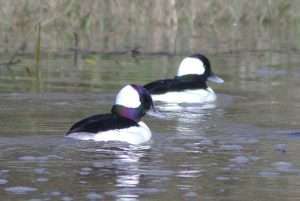
Name: Bufflehead (Bucephala albeola)
Range and typical habitat(s): Breeding range primarily in boreal and taiga habitats in western Canada and south-central Alaska with smaller breeding populations in surrounding areas; winters along both the Pacific coastline all the way from Alaska and Canada to northern Mexico, and inland in the southern half of the United States plus parts of the Pacific Northwest and Great Lakes regions, and northern Mexico. Migratory routes may additionally take them through other areas of United States and Canada not mentioned above.
You’re most likely to find them around water, whether quiet coastal areas or inland freshwater lakes, bays, and other waterways. Like other waterfowl they prefer places with plenty of vegetation around the water’s edge for shelter. Lakes are their preference during breeding season.
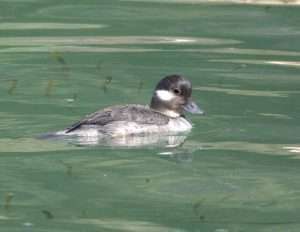
Distinguishing physical characteristics (size, colors, overall shapes, detail shapes) and behaviors: The short version is: the bufflehead is a small duck with a big head. To be more detailed about it, they are generally about 12-16 inches in length, smaller than most other duck species in the same range, with a wingspan a little less than two feet across. The dark-colored bill is comparatively small, making up less than half the total length of the head, and the pointed tail is similarly compact. The upper bill has a concave curve down from the forehead to the tip. In flight the wings have distinctly pointed ends and the tail is spread into a wedge shape, with a quick, constant wingbeat.
It is the coloration that sets these birds apart, though. Males in breeding plumage are quite stunning, with an iridescent green-purple head that has a large white patch just behind the dark eye. The back is black, and the sides and belly are bright white, with a dark gray tail. The wing, when open, is dark with a prominent white band across the upper wing. The feet are bright pinkish-orange.
Females have a very dark gray to black head with a much smaller white patch behind the eye, a dark back and wing with gray sides, tail, and belly. Rather than a full white band, her gray to black wings have one smaller white patch apiece on the upper side, and dark underneath. Female buffleheads’ feet are dark gray to black. Immature males are similarly colored. Young ducklings, when still in down, are black with white patches on their cheeks.
Buffleheads are diving ducks, and make many short dives in search of aquatic invertebrates, fish eggs, and plants. In fact, they’re very rarely ever seen on dry land, and spend most of their time on the water eating, resting, or preening. They tend to live in small groups during non-breeding months rather than the large flocks of some other waterfowl. They may linger in their breeding grounds later than many other ducks before heading south or to the coast for winter.
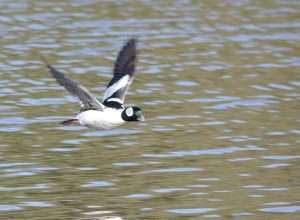
During breeding season buffleheads are generally monogamous with their partners from previous years, and they are cavity nesters, dependent on holes in dead trees made by woodpeckers. These small ducks especially prize holes made by northern flickers (Colaptes auratus) as they are too small for larger ducks to fit into but are perfectly bufflehead-sized. They may also make use of similarly-sized nest boxes. Larger ducks may aggressively force buffleheads out of prime nesting sites, and goldeneyes (Bucephala spp.) may even injure or kill the smaller buffleheads in fights over nests.
Courtship displays include the male soaring over the female, then coming to a spectacular sliding landing on the water’s surface, followed by some energetic head bobs. Once mates have established a territory, they defend it aggressively from other buffleheads.
The female bufflehead will lay anywhere from four to seventeen eggs with plain, cream-colored shells. These hatch after thirty days of incubation, and once the youngest duckling has spent a day in the nest the female and all the ducklings jump out of the box and head straight for the water. Meanwhile, females that were unsuccessful in breeding spend time looking for potential nesting sites for next year.
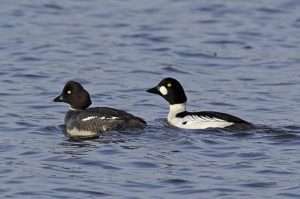
Other organisms it could be confused with and how to tell the difference: Buffleheads are most commonly mistaken for their larger Bucephala cousins, the common goldeneye (Bucephala clangula) and Barrow’s goldeneye (Bucephala islandica). Both species of goldeneyes, as their name suggests, have yellow eyes instead of the dark eyes of the buffleheads, and are larger overall. Male common goldeneyes lack the white head patch and instead have a smaller white patch in front of the eye, while females lack any white facial markings at all. When folded, the male common goldeneye’s wing has small white patches divided by thin black lines. The female common goldeneye has an orange tip on her beak, and her head is a lighter, ruddier brown than that of the female bufflehead. Both common goldeneye sexes have orange legs.
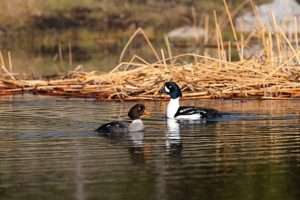
The Barrow’s goldeneye is similar to the common, but the male Barrow’s white face patch is larger and more oval in shape compared to the common’s round patch. The white wing patches on the Barrow’s male are smaller, and there is a small black hook shape at the shoulder. Female Barrow’s have an entirely orange beak except for a tiny bit of black at the tip.
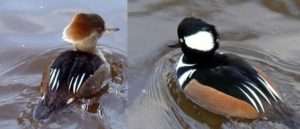
The hooded merganser also looks somewhat similar to the bufflehead, but is much larger, reaching over nineteen inches in length. The male hooded merganser in breeding colors does have a black head, but the white patch on the large crest behind the eye is much larger than in the bufflehead, and the black lacks the purple-green iridescence. His sides are reddish-brown and he has prominent white stripes on his black wings. The female hooded merganser lacks white markings on her face and has a yellow beak. Her head is a lighter grayish brown with a larger crest, and her body is also a lighter gray than that of the female bufflehead. Both merganser sexes have yellow rather than dark eyes.
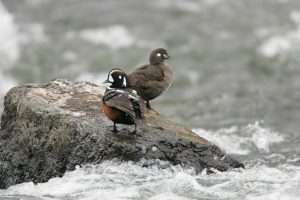
Another species that is markedly larger than the bufflehead is the harlequin duck. The male does have a black head, but he has a large white patch in front of his eye and two small ones behind it, with a white stripe on top of his head. His body is gray and he has prominent rust patches on top of his head and on his sides, and a white stripe on his back. The female harlequin duck is a plain brownish-gray with a large white patch in front of the eye and a much smaller one behind, and her underside is light gray with darker gray spots.
Further Reading:
Audubon Field Guide: Bufflehead
Aquarium of the Pacific: Bufflehead
